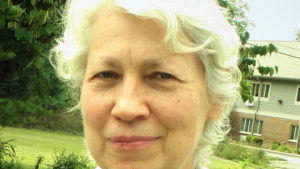#15 A NOTE ON PAT DONEGAN’S PASSING

“I go willingly into the sound of the crickets.”
–Pat Donegan, on her deathbed
I hadn’t planned to write on Pat, but then, who really plans on death—even when they see it coming? She died on the evening of January 25th in her hometown of Chicago after a difficult illness. Interestingly enough, I had recently invoked her name and instruction as my haiku teacher in Blog #8 KEROUAC’S HAIKU. I had a little hope that she might see what I wrote about haiku in that and the subsequent entries, though I also thought I wasn’t saying anything she didn’t understand far better than me.
But this brings me right up against something that’s only too familiar: what you didn’t say to a person when they were still around for you to say it.
I was about 21 in 1981 when I took her class on Japanese poetry, in my first semester at Naropa. I literally chose it because I knew nothing about Japanese literature. Among its different forms, haiku of course has a long history as a meditative art, congenial to the spare, essential Zen mentality. Under her tutelage, I started haiku as a practice, something I’ve maintained up to this day.
It wasn’t just haiku, though I’ve always regarded that as maybe the most irreducible of poetic forms to hone the poet’s mind on, but how Pat provided a gateway into far eastern literature. You can trace the Japanese and Korean poetic sensibilities to classical Chinese literary aesthetics. T’ao Ch’ien, Wang Wei, Li Ch’ing Chao, Li Po, Tu Fu, and the other classical Chinese masters have functioned for me as a mothersource of poetics, something I’ve returned to again and again over the decades to refresh and re-ground my sense of lyric writing. I felt guided into this by Pat and her understanding of how such poets approached their work.
In fact, about a year and a half ago, I put together a chapbook worth of Tu Fu translations/versions that I’d hoped to send Pat whenever I got them to print (coming sometime from Antarabhava Press).
Pat had lived in both Korea and Japan, and she knew and worked with some writers in both places, but especially haiku master Seishi Yamaguchi. This had to be in my consciousness somewhere when I moved to Korea myself in 1995 (visiting both Japan and China a number of times). When I learned of a classical, three line Korean form called shijo (the lines are much longer than in haiku) through a book I found on the shelf of the English school I worked at in downtown Seoul (well, I actually stole the book off that shelf), I decided to use the poems as conversation topics for my classes, and we would translate them together into English pretty much as a way to entertain the teacher. I got deeply into this and produced a book of shijo in English (coming sometime from Antarabhava Press), again largely due to Pat’s influence.
Back in the day, she would read from her Hot Haiku book her own poems of three line lesbian erotica. I should have bought one—I don’t have any of her own creative writing. She produced translations and commentary for broader public anthologies—Love Haiku (2010) and Haiku Mind (2008), both from Shambhala Pubs—but what strikes me as her most meaningful contribution was Chiyo-ni: Woman Haiku Master (Tuttle, 1998), bringing into literary and scholarly focus an artist who had ceased to receive her due in Japan itself.
Here are some of her Chiyo-ni translations, done with Yoshie Ishibashi:
to the one breaking it—
the fragrance
of the plum
woman’s desire
deeply rooted—
the wild violets
winter rain—
in one room
yesterday, today passes
Yesterday, today passes in that solitary room of one’s mind, and then you look around, and the years have washed away. As a teacher, you don’t always know how you’ll affect students. Maybe you imprint some of them with one or two things you say. Maybe some actually pick up your torch and carry it for themselves (I can name at least a couple of my compatriots from her classes who, like me, still do so today). Many won’t remember anything or care at all. I’m unavoidably sad that this is how I’ve had to explain to her all her positive influence on my life as a writer, in words she’ll never read. Maybe that’s just the sadness that inevitably attends writing them—or living them.
For Pat Donegan, in Memoriam
The teacher has passed,
& all that remains with the student
are words.


Simply lovely. She sounds like a wonderful influence on your life. She did well.
Oh my. This is so fine. A fine tribute to a teacher. I’ve been thinking about studying haiku. Do you have any suggestions? Thanks.
Probably my favorite haiku book is by Robert Haas, The Essential Haiku, and that will tell you something about the lives and art of the great classical Japanese haiku poets, Basho, Buson, and Issa, with very good renderings of their poems in English. I’m not sure what’s out there by way of a straightforward instruction manual in how to do it. People have a lot of ideas about that, including formal senses that aren’t always held to by even the classical writers, all the way to they just call it “haiku,” but maybe it bears little resemblance to the sensibility beyond it’s short. I’m happy to send you a few pointers, if you think that would help.
Thank you, Gary, for your wonderful words and sentiments for our dear friend. I can see her smile.
Ahaa…Haiku
I too miss her.
Thank you for speaking for those of us who had the honor of knowing her
but not the eloquence of either of you.